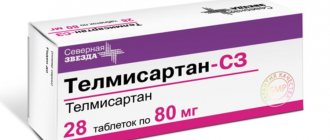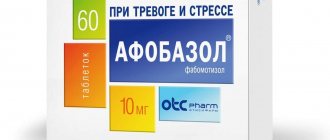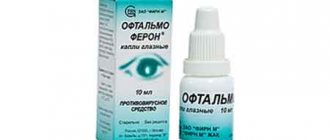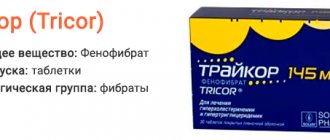- June 23, 2019
- Infectious
- Smirnova Alexandra
New generation penicillin antibiotics include a drug called Amoxicillin Sandoz. It has a wide spectrum of action. The drug fights coccal flora. It has good resistance to acidic environments, making it suitable for oral use. The medicine is produced by the Austrian company Sandoz.
Release form and composition
Dosage form - film-coated tablets: oblong (0.5 g each) or oval (1 g each), biconvex, with notches on both sides, from white to slightly yellowish in color (dosage 0.5 g: 10 and 12 pcs in blisters, in a cardboard box 1 blister and instructions for use of Amoxicillin Sandoz; packaging for hospitals - in a cardboard box 100 blisters of 10 tablets each; dosage 1 g: 6 and 10 pcs in blisters, in a cardboard box 2 blisters and instructions to the drug; packaging for hospitals - 100 blisters in a cardboard box).
Composition of 1 tablet:
- active ingredient: amoxicillin (in the form of trihydrate) - 0.5 or 1 g;
- auxiliary components: microcrystalline cellulose, povidone, sodium carboxymethyl starch (type A), magnesium stearate;
- film shell: hypromellose, talc, titanium dioxide.
Precautionary measures
Before prescribing, it is necessary to make sure that the pathogens are not resistant to the composition; it is important to take into account the variable resistance properties of some strains.
For severe infections of the digestive system, oral administration is not recommended, which is associated with prolonged diarrhea, nausea and poor absorption. For such patients, the medicine is replaced with amoxicillin powder to prepare a solution used parenterally. Also, drugs against peristalsis disorders are not prescribed.
The doctor monitors the condition of the kidneys, blood-forming organs and liver. The product is not suitable for the treatment of respiratory diseases. To prevent crystalline formations of the active substance, you need to monitor the hydrolysis balance in the body.
Pharmacological properties
Pharmacodynamics
Amoxicillin, the active component of the drug, is a semi-synthetic penicillin with a bactericidal effect.
The mechanism of action is due to the ability of amoxicillin to damage the cell membrane of bacteria that are in the reproduction stage. The drug specifically inhibits enzymes in the cell membranes of microorganisms (peptidoglycans), resulting in their lysis and death.
Amoxicillin Sandoz is active against the following bacteria:
- gram-positive aerobic microorganisms: Streptococcus spp. (including S. pneumoniae), Listeria monocytogenes, Enterococcus faecalis, Bacillus anthracis, Staphylococcus spp. (except penicillinase-producing strains), Corynebacterium spp. (except C. jeikeium);
- gram-negative aerobic microorganisms: Neisseria spp., Borrelia spp., Shigella spp., Helicobacter pylori, Escherichia coli, Salmonella spp., Campylobacter, Haemophilus spp., Proteus mirabilis, Leptospira spp., Treponema spp.;
- anaerobic bacteria: Fusobacterium spp., Bacteroides melaninogenicus, Peptostreptococcus spp., Clostridium spp.;
- others: Chlamydia spp.
Amoxicillin Sandoz is inactive against the following microorganisms:
- gram-positive aerobic bacteria: Staphylococcus (lactamase-producing strains);
- gram-negative aerobic bacteria: Klebsiella spp., Citrobacter spp., Proteus spp., Acinetobacter spp., Pseudomonas spp., Serratia spp., Moraxella catarrhalis, Enterobacter spp., Providencia spp.;
- anaerobic bacteria: Bacteroides spp.;
- others: Rickettsia spp., Mycoplasma spp.
Pharmacokinetics
After oral administration of a dose of Amoxicillin Sandoz 0.5 g, the plasma concentration of the drug ranges from 6 to 11 mg/l. The time to reach maximum plasma concentration is 1–2 hours. Food intake does not affect absorption (rate and extent). Absolute bioavailability is dose-dependent and can be 75–90%.
15-25% of the received dose is bound to plasma proteins. Amoxicillin quickly penetrates into bile, bronchial secretions, lung tissue, urine, and middle ear fluid. It penetrates into the cerebrospinal fluid in small quantities provided there is no inflammation of the meninges, otherwise the content in the cerebrospinal fluid can reach 20% of the plasma concentration. Penetrates through the placenta, in small quantities into breast milk.
Up to 25% of the dose taken is metabolized to form penicillic acid, which has no pharmacological activity.
Excreted: 60-80% of the dose - unchanged by the kidneys within 6-8 hours after taking Amoxicillin Sandoz, a small amount - with bile.
The half-life (T½) is 1-1.5 hours, and in case of end-stage renal failure it can vary between 5-20 hours.
Amoxicillin is removed from the body during hemodialysis.
General information
The drug is a partially synthetic aminobenzyl penicillin that dissolves the cell wall of both gram-negative and gram-positive pathogenic microorganisms. The impact on the infectious agent occurs at the proliferation stage. The antibiotic inhibits the synthesis of the cell membrane, followed by its dissolution and death.
When treating with the drug, it is important to take into account the geographic distribution of resistant strains, especially during epidemic outbreaks and in severe cases of pathology. If the use of a medication becomes impractical due to the resistance of microorganisms, it is necessary to seek help from a specialist. The effect of the drug is detrimental to both aerobic and anaerobic flora, including:
- Pneumococci and streptococci.
- Enterococci and corynebacteria are prone to variable resistance.
- Listeria and bovis.
- Causative agents of anthrax.
- Cholera vibrios.
- Meningococci and Brucella.
- Shigella and Protea.
- Salmonella.
- Gonococcal flora.
- E. coli.
- Bacteria Helicobacter pylori.
- Peptostreptococci and clostridia.
- Fusobacteria and bacteroides.
Some pathogenic microorganisms have multiple drug resistance factors, resulting in variable and unpredictable behavior of infectious agents. To combat bacteria that produce beta-lactamase, Sulbactam and clavulanic acid are used.
Indications for use
Amoxicillin Sandoz is used in the treatment of infectious and inflammatory diseases caused by bacteria sensitive to the drug:
- ENT organs, upper and lower respiratory tract: acute otitis media, tonsillitis, pharyngitis, pneumonia, bronchitis, lung abscess;
- genitourinary system: cystitis, endometritis, adnexitis, septic abortion, pyelitis, pyelonephritis, epididymitis, urethritis, chronic bacterial prostatitis, etc.;
- gastrointestinal tract: bacterial enteritis (for infections caused by anaerobic microorganisms, the drug is often used as part of combination therapy);
- biliary tract: cholecystitis, cholangitis;
- listeriosis, leptospirosis, Lyme disease (borreliosis);
- skin and soft tissue infections;
- endocarditis (including for its prevention during dental procedures).
Amoxicillin Sandoz tablets are also used as part of combination therapy (together with clarithromycin, metronidazole or proton pump inhibitors) for the eradication of Helicobacter pylori.
When is the drug prescribed?
According to the instructions and reviews, Amoxicillin Sandoz (1g) is recommended for use in the presence of the following conditions and ailments:
- Bacterial diarrhea.
- Dysentery.
- Otitis media and external.
- Endocarditis.
- Inflammation of the mucous membrane of one or more paranasal sinuses.
- Acute pharyngitis.
- Diffuse inflammation of the bronchial mucosa, involving the deep layers of the bronchial wall with the development of peribronchitis.
- Pneumonia.
- Inflammatory process in the bladder.
Contraindications
Absolute:
- children under 3 years of age;
- hypersensitivity to other beta-lactam antibiotics, for example, cephalosporins or carbapenems (possible cross-reaction);
- breast-feeding;
- hypersensitivity to any component of the drug or penicillin.
Amoxicillin Sandoz tablets should be used with caution in the following cases:
- severe digestive disorders accompanied by prolonged diarrhea/vomiting;
- renal dysfunction;
- viral infections;
- bronchial asthma;
- allergic diathesis;
- infectious mononucleosis (increased risk of erythematous skin rash);
- acute lymphoblastic leukemia;
- children's age from 3 years;
- pregnancy (the benefits to the mother must outweigh the risks to the fetus).
Price of Amoxicillin tablets
Depending on the dosage, number of tablets and manufacturer, the cost of the antibiotic Amoxicillin changes:
- Hemofarm 16 pieces of 500 mg – 90 rubles;
- Hemofarm 16 capsules 250 mg – 58 rubles;
- Sandoz 12 pieces of 1000 mg – 165 rubles;
- Ava Rus 20 tablets of 500 mg – 85 rub.
The cost of the drug 500 mg differs in various online pharmacies:
- apteka.ru – from 38.7 rubles;
- eapteka.ru – from 90 rubles;
- pharmindex.ru – from 45.02 rubles;
- uteka.ru – from 33 rub..
Amoxicillin Sandoz, instructions for use: method and dosage
Amoxicillin Sandoz should be taken orally. The duration of treatment is determined individually. It is usually recommended to continue taking the drug for another 2-3 days after the symptoms disappear. For infections caused by β-hemolytic streptococcus, therapy for at least 10 days is required to completely eradicate the pathogen.
Adults and children weighing more than 40 kg (over 12 years), depending on the severity of the infectious process, are prescribed the drug in a daily dose of 0.750-3 g (in several doses).
For uncomplicated urinary tract infections, short courses of treatment are carried out using a dose of 3 g 2 times a day (at intervals of 10–12 hours).
For children under 12 years of age, Amoxicillin Sandoz is prescribed in a daily dose of 25–50 mg/kg (in several doses), but not more than 60 mg/kg per day. The optimal dosage is determined by the indication and severity of the disease.
For patients with severe renal failure, the dosage regimen of Amoxicillin Sandoz is adjusted. If creatinine clearance is <30 ml/min, reduce subsequent doses and/or increase the intervals between doses. The administration of short courses using a single dose of 3 g is contraindicated.
Recommended doses for adult patients (including the elderly) and children weighing more than 40 kg with impaired renal function:
- CC 10–30 ml/min – 0.5 g every 12 hours;
- CC < 10 ml/min – 0.5 g every 24 hours.
On the day of hemodialysis, take a dose of Amoxicillin Sandoz after the end of the session.
Recommended doses for children weighing less than 40 kg:
- CC 10–30 ml/min – 15 mg/kg every 12 hours;
- CC < 10 ml/min – 15 mg/kg every 24 hours.
For the prevention of endocarditis in adult patients not under general anesthesia, Amoxicillin Sandoz is prescribed at a dose of 3 g 1 hour before surgery. If necessary, it is possible to re-use a similar dose 6 hours after the intervention. For children, the recommended dose is 50 mg/kg. More detailed information and descriptions of the categories of patients at risk of developing endocarditis are contained in local official guidelines.
Analogs
Preparations that are identical to the product we are describing are produced by both Russian and foreign manufacturers, and they contain exactly the same components and have a similar effect.
For example, Amosin is a domestically produced drug; it is produced in powder, granular, and also in liquid form. The solution is administered intravenously or intramuscularly. Suspensions are prescribed for the treatment of children. When taking a large dosage, the medication concentrates in the liver. This analogue is highly acid-resistant, so it can be taken before or after meals. It is not recommended to give the product to children under three years of age. This is one of the cheapest substitutes for Amoxicillin Sandoz; its cost ranges from twenty-six to fifty-four rubles.
The Ecobol analogue is available in tablet dosage form. Indications for use are the same as the original, the active substance of which is the main ingredient in the composition. This medicine is good for colitis resulting from antibiotic treatment. Long-term therapy requires monitoring the patient's condition. People who have a history of bacteremia may experience endotoxic shock. The advantage of the presented analogue is the presence of lactulose in the composition, which promotes the growth of beneficial flora and prevents the development of dysbacteriosis. The price for it varies depending on the place of sale and the dosage of the pills and ranges from fifty to one hundred and twenty rubles.
The drug "Ospamox" is a four-hydroxyl substitute for "Amoxicillin Sandoz", presented in the form of a powder from which a suspension is prepared. Contains fruit flavors along with anhydrous citric acid, trisodium citrate and precipitated silica. For the treatment of exacerbations of ulcerative pathologies and chronic forms of gastritis, combined use with Metronidazole is desirable. But if the patient has liver disease, such treatment is contraindicated. The minimum cost is one hundred forty-five rubles.
"Flemoxin Solutab" is presented in the form of oval dispersible tablets, which have the manufacturer's logo on one side with dividing stripes on the reverse. The advantage of this analogue is the possibility of its use in pediatrics. The drug is produced by the Dutch company. The cost of 0.5 gram pills ranges from three hundred to four hundred rubles.
The Amoxiclav analogue in tablets has two different dosages - 500 and 125 milligrams, which makes it possible to regulate their intake according to therapeutic indications. The drug can be used in combination with other antibiotics that belong to different groups. The cost varies from two hundred to four hundred and fifty rubles.
The drug "Amoxicar" is used to destroy staphylococcal and other pathogenic flora. Suspensions are prescribed in childhood, from birth to twelve years, and capsules with tablets are intended for adult patients.
"Rapiklav" is an Indian antibiotic containing potassium salt in its composition. It is used to treat osteomyelitis, salpingitis, sinusitis, and in addition, it helps well with purulent wounds and phlegmon. Due to its low toxicity, it can be well tolerated by patients.
Augmentin is a drug based on amoxicillin and clavulanic acid. It is used during lactation, provided that the child does not have reactions such as diarrhea, conjunctivitis and candidiasis of the mucous membranes.
"Clonacom X" is a combination drug that contains cloxacillin. It is used for sexually transmitted diseases - gonorrhea, syphilis.
It is worth noting that the substance amoxicillin is the main component of all similar drugs. The difference between Amoxicillin Sandoz and just Amoxicillin is the number of additional auxiliary ingredients in the composition. In addition, these medications are produced by different manufacturers, and they can differ significantly in cost. For example, for Amoxicillin Sandoz with a dosage of 1 gram the price will be from one hundred twenty to one hundred fifty rubles. And regular Amoxicillin costs fifty-three rubles per pack.
Side effects
While taking Amoxicillin Sandoz, the following side effects may develop (according to the frequency of development, these adverse reactions are classified as follows: more than 10% - very frequent; 1-10% - frequent; 0.1-1% - infrequent; 0.01-0. 1% – rare; less than 0.01% – very rare):
- blood and lymphatic system: often – eosinophilia, leukopenia; rarely – neutropenia, agranulocytosis, thrombocytopenia; very rarely - anemia (including hemolytic), pancytopenia, thrombocytopenic purpura;
- nervous system: often – drowsiness, dizziness, headache; rarely - behavior change, anxiety, agitation, sleep disturbance, anxiety, tremor, ataxia, paresthesia, peripheral neuropathy, confusion, nervousness, convulsions, depression; very rarely - impaired sense of smell, vision and tactile sensitivity, hyperesthesia, hallucinations;
- cardiovascular system: often – phlebitis, tachycardia; rarely – decreased blood pressure; very rarely - prolongation of the QT interval;
- gastrointestinal tract and liver: very often – changes in taste, glossitis, stomatitis, dysbacteriosis; often - diarrhea, nausea, increased concentration of bilirubin in the blood serum and liver parameters (alanine aminotransferase, aspartate aminotransferase, alkaline phosphatase, γ-glutamyltransferase); rarely – pain in the epigastric region, dyspepsia, vomiting, cholestatic jaundice, hepatitis; very rarely - the appearance of a black color of the tongue, diarrhea mixed with blood, pseudomembranous colitis, acute liver failure;
- skin and subcutaneous tissues: often – rash, pruritis; rarely - urticaria; very rarely - swelling of the skin and mucous membranes, photosensitivity reactions, toxic epidermal necrolysis (Lyell's syndrome), malignant exudative erythema (Stevens-Johnson syndrome);
- endocrine system: rarely – anorexia; very rarely – hypoglycemia (especially in patients with diabetes mellitus);
- respiratory system: rarely – bronchospasm, dyspnea; very rarely - allergic pneumonitis;
- musculoskeletal system: rarely - tendon diseases (including tendinitis), myalgia, arthralgia; very rarely - muscle weakness, tendon rupture (sometimes bilateral), rhabdomyolysis;
- genitourinary system: rarely – interstitial nephritis, increased concentration of creatinine in the blood serum;
- other: vaginal candidiasis, difficulty breathing; rarely - a feeling of weakness, reactions similar to serum sickness, the development of superinfection (especially in persons with reduced body resistance and patients with chronic diseases); very rarely - increased body temperature, anaphylactic shock.
special instructions
A prerequisite for successful therapy is the sensitivity of the causative agent to the drug, therefore, before prescribing Amoxicillin Sandoz, it is necessary to conduct appropriate studies.
In severe infectious and inflammatory processes of the gastrointestinal tract, accompanied by constant diarrhea or vomiting, there may be a significant decrease in the absorption of the drug and, as a result, a decrease in its effectiveness, so oral use of the antibiotic may be inappropriate.
If mild diarrhea occurs during a course of treatment, you should not take antidiarrheals that reduce intestinal motility. It is recommended to take medications containing kaolin or attapulgite. If severe diarrhea develops, consult a doctor.
If severe persistent diarrhea occurs, Amoxicillin Sandoz should be discontinued and appropriate studies should be performed to exclude the presence of pseudomembranous colitis caused by Clostridium difficile. It is contraindicated to take drugs that slow down intestinal motility.
With prolonged treatment, it is necessary to monitor blood counts, kidney and liver function.
Particular caution should be exercised during therapy in patients with bronchial asthma, allergic diathesis, and a history of colitis associated with the use of antibiotics. For long-term treatment, Amoxicillin Sandoz should be used in combination with levorin, nystatin or other antifungal agents.
Patients with hypersensitivity to penicillins are at risk of developing cross-allergic reactions with other beta-lactam antibiotics.
For acute respiratory viral infections, Amoxicillin Sandoz is low-effective and therefore not recommended for use.
Women taking estrogen-containing oral contraceptives should use other or additional methods of contraception during antibiotic therapy.
While taking Amoxicilian Sandoz, there are no changes in the results of the enzymatic analysis of glucosuria, but it is possible to obtain false-positive reactions in a urine test for glucose.
During therapy, it is necessary to ensure an abundant supply of fluid to the body to prevent the formation of amoxicillin crystals in the urine. It is not recommended to drink alcoholic beverages.
Due to the growth of insensitive microflora, superinfection may develop. In this case, a change in the antibacterial therapy regimen is required.
Impact on the ability to drive vehicles and complex mechanisms
Amoxicillin Sandoz in some cases causes side effects that affect the speed of reactions and the ability to concentrate (headache, drowsiness, confusion). In this regard, it is recommended to take precautions when driving a car and engaging in potentially hazardous activities.
Reviews
According to comments from patients and doctors, this antibiotic has proven itself to be an effective remedy in the fight against various ailments. In some cases, people report complete recovery after treatment with the described medication. It is worth noting that the affordable price makes this drug very popular among buyers.
Doctors say that they prescribe this penicillin antibiotic to their patients for staphylococcal, streptococcal and other infections. According to doctors, it shows good results in the treatment of sore throat, sinusitis and otitis. If the disease is treated promptly, the drug will help cope well with pathogens.
Many doctors, in their reviews of Amoxicillin Sandoz, report that the effectiveness of this medicine has been repeatedly proven in practice. But, like other similar drugs, this one has side reactions and contraindications, which sometimes causes complaints. It is well known that antibiotics are harmful medications for beneficial microflora; therefore, before therapy, it is imperative to take care of purchasing drugs that prevent its destruction. Otherwise, according to experts, this is a very good and reliable remedy for getting rid of bacterial infections.
As for the opinions of patients, some of them write that it was thanks to Amoxicillin that Sandoz got rid of bronchitis and sinusitis, and in order to prevent dysbiosis from appearing, they took prebiotics. There are practically no complaints from patients about side effects in reviews. Only a few people mention the occurrence of diarrhea and headaches.
Otherwise, all the comments are positive, people are happy with this medicine and report that it perfectly helps prevent the disease from developing complications. The symptoms of the pathology disappear after three days. Many admit that the whole family is treated with this antibiotic if necessary. What Sandoz tablets help with is indicated in the instructions (we also considered this issue).
Use during pregnancy and lactation
Animal studies have shown that amoxicillin does not have mutagenic, teratogenic or embryotoxic effects. However, adequate and strictly controlled studies have not been conducted in pregnant women, so the use of Amoxicillin Sandoz is possible only in cases where the expected benefits outweigh the potential risks.
Amoxicillin passes into mother's milk and can cause diarrhea, fungal colonization of the mucous membrane, and the development of sensitization to beta-lactam antibiotics in an infant. If a woman is indicated for antibiotic therapy, she should stop breastfeeding.
Drug interactions
- other bacteriostatic agents (chloramphenicol, tetracyclines, macrolides, sulfonamides): antagonism may develop; when combined with aminoglycosides, a synergistic effect is possible (it is recommended to avoid these combinations);
- Digoxin: its absorption time may increase;
- probenecid: the excretion of amoxicillin by the kidneys decreases, and its concentration in the blood and bile increases;
- disulfiram: the risk of allergic reactions increases (their combined use should be avoided);
- ascorbic acid: absorption of amoxicillin increases;
- glucosamine, laxatives, aminoglycosides, antacids: absorption of amoxicillin slows down;
- allopurinol: increases the risk of skin rash;
- non-steroidal anti-inflammatory drugs, diuretics, oxyphenbutazone, allopurinol, phenylbutazone and other drugs that block tubular secretion: the plasma concentration of amoxicillin increases;
- methotrexate: its toxicity may increase;
- estrogen-containing oral contraceptives: their effectiveness decreases;
- ethinyl estradiol: the likelihood of breakthrough bleeding increases;
- indirect anticoagulants: their effect is enhanced (due to suppression of intestinal microflora, decreased synthesis of vitamin K and prothrombin index).
Combinations with other medications
The main active substance, interacting with various drugs, may exhibit a negative reaction, or enhance the effect of therapy with certain drugs:
- Allopurinol causes allergies manifested in skin rashes
- Anticoagulants increase the risk of bleeding, so it is necessary to monitor prothrombin intervals
- Probenicide changes the conditions of excretion: it reduces the percentage of excretion through urine and increases the content in the bile ducts and plasma
- Macrlides, sulfonamides, tetracycline group are incompatible with ampicillin
- Cytostatic drugs from the metabolite category increase toxicity
- The use of hormonal oral contraceptives loses effectiveness
- Cephalosporins and other penicillin antibiotics can cause allergies
- Complete antagonism with ethanol.
For a long course, it is recommended to simultaneously take antifungal medications: Nystatin or Levorin. This will help preserve the intestinal microflora and protect against conditions favorable for the development of Helicobacter pylori, which causes pseudomembranous enterocolitis.









![Grippostad with instructions for use [2]](https://karipazim-farm.ru/wp-content/uploads/grippostad-s-instrukciya-po-primeneniyu-2-330x140.jpg)
